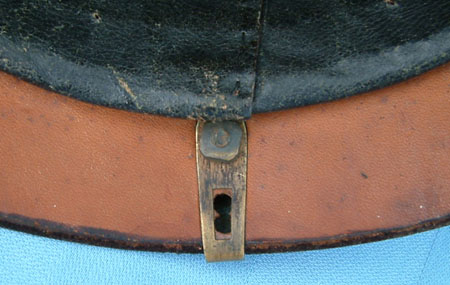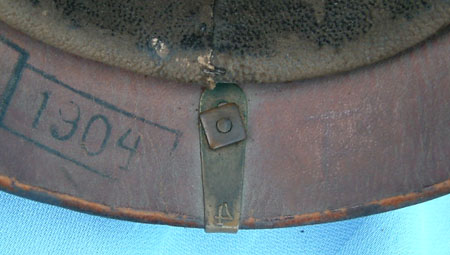You are using an out of date browser. It may not display this or other websites correctly.
You should upgrade or use an alternative browser.
You should upgrade or use an alternative browser.
Feldartillerie Fall Number 2. Sachsen FAR
- Thread starter Tony without Kaiser
- Start date
-dick rowback
New member
=D>  Tony; Another wonderful artillery helmet, but that waffenrock and those shoulderboards are fantastic! How do you do it, you always keep coming up with new things! Lova those artilleries! Dick
Tony; Another wonderful artillery helmet, but that waffenrock and those shoulderboards are fantastic! How do you do it, you always keep coming up with new things! Lova those artilleries! Dick
joerookery
Well-known member
Nice write up! A wonderfully marked helmet. I have a couple of questions that I don't pretend to know the answer of. You have certainly handled a lot of these examples. I know that the 1903 Prussian Bekleidungsordnung made it clear that there was no air vent on the rear spine for Field artillery. Where do I look to find a later direction of this? You indicate that all artillery did not have this vent in peacetime did you find something that actually lumped foot and field together? I have been struggling with this split. In this Prussian example below Field artillery is completely separate from foot units. Even though the foot units are not really all on foot. Maybe the division should be those not mounted on horses??? Based on your experience, have you noticed a construction or qualitative difference between examples of infantry helmets and field artillery specific helmets? Are the metal fittings of different material? It seems, though I have chased some difference in the metal between the two different types, but I have not finished this conclusively.




I have no AKO to point you towards Joe. I only know that FAR helmets with pre-war dates, do not (typically) have rear vented M1895 spines. They should have M91 rounded chinscales as well. Once you start seeing dates 1914 and after, you start seeing the rear air vent, which I (assume) is standardization of parts. This is also when you start seeing the 3mm wide M91 leather chinstraps to fit the mounted Troops M91 posts with the scales removed.
http://www.kaisersbunker.com/hp/hp21.htm
As far as Füßartillerie, I would expect that they would have adopted the rear spine prior to 1914 as they adopted the M91 leather chinstrap, but the examples I have seen, had none.
Yes, this is a great little helmet, very heavy, and solid like a rock.

http://www.kaisersbunker.com/hp/hp21.htm
As far as Füßartillerie, I would expect that they would have adopted the rear spine prior to 1914 as they adopted the M91 leather chinstrap, but the examples I have seen, had none.
Yes, this is a great little helmet, very heavy, and solid like a rock.

reservist1
Member
Tony & Joe: I have an issue 10th foot artillery helmet dated 1902 which has a vented rear spine. I also have an issue field artillery helmet from the Field Artillery School dated 1902 that has a non vented rear spine.
Reservist1
Reservist1
reservist1
Member
Maybe the division should be those not mounted on horses???
Joe: I don't believe this division will work. In standard field artillery units the gun crews rode on the gun and limber. However in field artillery units having Reitende batteries all members of the battery were horse mounted.
As a result in field artillery regiments having a reitende battery (for example FAR 34) there are both vehicle (gun/limber) and horse mounted troops in the same regiment. There is no difference in helmets for reitende batteries and other members of the regiment. They all wore the standard field artillery helmet.
Reservist1
joerookery
Well-known member
I agree that that was a crummy division. I just don't understand entirely why Field artillery is so separated. It did not seem to have a major impact on the commissioning process -- by that I mean both foot and field were not the most sought-after posts.
Have either of you seen a difference in metal construction, or use?
Have either of you seen a difference in metal construction, or use?
joerookery said:Have either of you seen a difference in metal construction, or use?
Eh? Not sure if I understand? Well, actually...I am sure...I don't understand what you mean?
And its not just FAR Joe, don't forget that Dragoner and Chevaulegers also did not use the vented M95 spine either. Basically, it seems that if you were walking, you got the rear vented M95 spine. If you were mounted, (which includes hanging on to a gun limber for dear life) no vent.
pointystuff
Active member
Could it be that the army was saving money by using the unvented spines for mounted troops?
Brad
Brad
reservist1
Member
Could it be that the army was saving money by using the unvented spines for mounted troops?
We need to keep in mind that the issue helmet bodies themselves are different between helmets with vented rear spines and those without vented spines. The helmet body for a non vented spine does not have the round hole behind the spike/ball base or the rectangular hole in the rear visor. Issue helmets designed for the vented spine have these two holes. The holes are necessary for the vented spine to, in theory, allow air circulation.
Given the differences in the helmet bodies it is doubtful that the use of the non vented spine was solely a cost saving measure.
Reservist1
reservist1 said:The helmet body for a non vented spine does not have the round hole behind the spike/ball base or the rectangular hole in the rear visor.
The bottom ones are below.
The 1895 modification for Foot-Troops included a bottom vent which allowed air to circulate through the rear spine. See photo below.

Below is the no-bottom vent style worn by everyone from 1871 to 1895, and for so-called 'mounted troops' until 1914.

joerookery
Well-known member
Eh? Not sure if I understand? Well, actually...I am sure...I don't understand what you mean?
Boy if you don't get it think of what those guys who struggle with English must think! If I piece together the pieces of information that I have from two Bekleidungsordnung and some catalogs it seems like some field artillery could have different base metals used.


For instance this shows no aluminum bronze for Field artillery. The 1903 order gives Field artillery, the choice of tombac or brass, while foot troops are listed only as tombac. The lack of some dates, makes this all more confusing.
R1 I found something on contract pricing. Actually it is called Stadt Preis. However, what I think it means is the budgeted amount. For instance I have a price for the helmet shell of 5.50. You can buy that from Wunderlich for 4.50. The document that gives the price also gives the wear out length. So I think the war minister budgeted a price and gave that to the corps to use.
joerookery said://and some catalogs//
So you are referring to private purchase then Joe? Government purchased helmets bought in bulk under contract for issue would be made as per the Probe supplied to the manufacturer; private purchase helmets could be bought in the levels you show above in different materials. You know about the switch from Tombak to Alumbronze sometime after 1895 as the Tombak looked awful.
Typically, the fittings on even the highest quality Mannschaften helmets are brass, it is only the Wappen that is Alumbronze.... I have FAR examples where the Wappens are clearly Alumbronze. Personally, I try myself to avoid making generalizations based on catalogues.
joerookery
Well-known member
So you are referring to private purchase then Joe? Government purchased helmets bought in bulk under contract for issue would be made as per the Probe supplied to the manufacturer; private purchase helmets could be bought in the levels you show above in different materials.
No I'm not referring to private purchase. I'm referring to government purchased helmets bought in bulk under contract. It is not clear to me at all, the exact specifications of Probe requirements and how they were interpreted by the several Army Corps. I don't know the answer about metal usage. I don't even have a good clue. But I do not think you're going to find a great deal of standardization when the Minister of War negotiates the Probe and the individual corps write the contracts. I mean, it holds up better in smaller organizations like Bavaria or Saxony.
Personally, I try myself to avoid making generalizations based on catalogues.
I don't see this as a generalization based on a catalog. I think it is a general question that I cannot nail down. If all catalog's were only private purchase then they would not be useful for this. It really doesn't make a difference. I was just asking if you had seen some differences based on your experience. Darn nice helmet you have there.
joerookery said:I was just asking if you had seen some differences based on your experience.
Not really. Every issued FAR helmet I have ever owned or seen, had brass fittings, with a brass or Alumbronze Wappen. In fact, that would apply to every issue heolmet I have ever seen or owned; I have never seen one with Tombak or Alumbronze fittings.
reservist1
Member
I was just asking if you had seen some differences based on your experience.
I agree with Tony, I have never seen or owned an issue FAR helmet with fittings other than brass.
Reservist1

